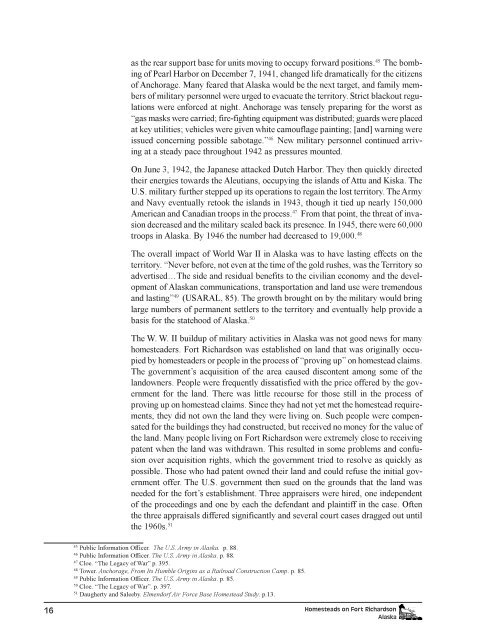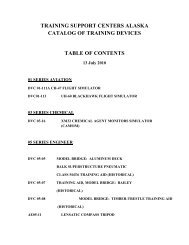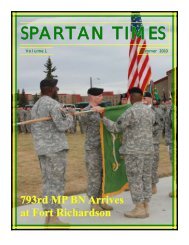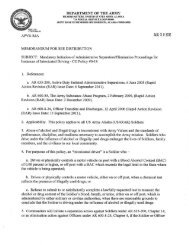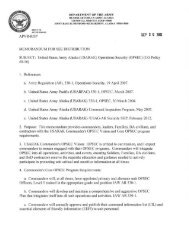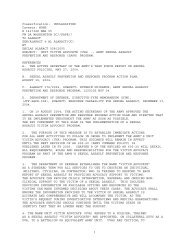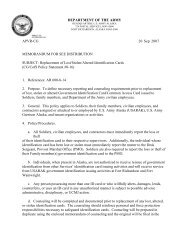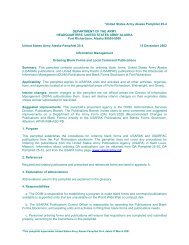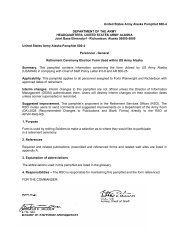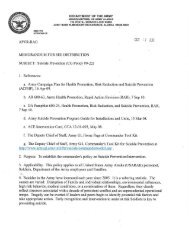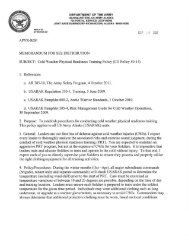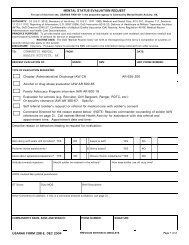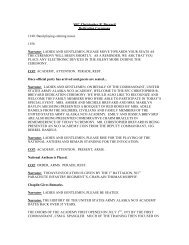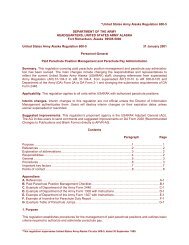Homesteads on Fort Richardson, Alaska - The USARAK Home Page ...
Homesteads on Fort Richardson, Alaska - The USARAK Home Page ...
Homesteads on Fort Richardson, Alaska - The USARAK Home Page ...
- No tags were found...
Create successful ePaper yourself
Turn your PDF publications into a flip-book with our unique Google optimized e-Paper software.
as the rear support base for units moving to occupy forward positi<strong>on</strong>s. 45 <strong>The</strong> bombingof Pearl Harbor <strong>on</strong> December 7, 1941, changed life dramatically for the citizensof Anchorage. Many feared that <strong>Alaska</strong> would be the next target, and family membersof military pers<strong>on</strong>nel were urged to evacuate the territory. Strict blackout regulati<strong>on</strong>swere enforced at night. Anchorage was tensely preparing for the worst as“gas masks were carried; fire-fighting equipment was distributed; guards were placedat key utilities; vehicles were given white camouflage painting; [and] warning wereissued c<strong>on</strong>cerning possible sabotage.” 46 New military pers<strong>on</strong>nel c<strong>on</strong>tinued arrivingat a steady pace throughout 1942 as pressures mounted.On June 3, 1942, the Japanese attacked Dutch Harbor. <strong>The</strong>y then quickly directedtheir energies towards the Aleutians, occupying the islands of Attu and Kiska. <strong>The</strong>U.S. military further stepped up its operati<strong>on</strong>s to regain the lost territory. <strong>The</strong> Armyand Navy eventually retook the islands in 1943, though it tied up nearly 150,000American and Canadian troops in the process. 47 From that point, the threat of invasi<strong>on</strong>decreased and the military scaled back its presence. In 1945, there were 60,000troops in <strong>Alaska</strong>. By 1946 the number had decreased to 19,000. 48<strong>The</strong> overall impact of World War II in <strong>Alaska</strong> was to have lasting effects <strong>on</strong> theterritory. “Never before, not even at the time of the gold rushes, was the Territory soadvertised…<strong>The</strong> side and residual benefits to the civilian ec<strong>on</strong>omy and the developmentof <strong>Alaska</strong>n communicati<strong>on</strong>s, transportati<strong>on</strong> and land use were tremendousand lasting” 49 (USARAL, 85). <strong>The</strong> growth brought <strong>on</strong> by the military would bringlarge numbers of permanent settlers to the territory and eventually help provide abasis for the statehood of <strong>Alaska</strong>. 50<strong>The</strong> W. W. II buildup of military activities in <strong>Alaska</strong> was not good news for manyhomesteaders. <strong>Fort</strong> Richards<strong>on</strong> was established <strong>on</strong> land that was originally occupiedby homesteaders or people in the process of “proving up” <strong>on</strong> homestead claims.<strong>The</strong> government’s acquisiti<strong>on</strong> of the area caused disc<strong>on</strong>tent am<strong>on</strong>g some of thelandowners. People were frequently dissatisfied with the price offered by the governmentfor the land. <strong>The</strong>re was little recourse for those still in the process ofproving up <strong>on</strong> homestead claims. Since they had not yet met the homestead requirements,they did not own the land they were living <strong>on</strong>. Such people were compensatedfor the buildings they had c<strong>on</strong>structed, but received no m<strong>on</strong>ey for the value ofthe land. Many people living <strong>on</strong> <strong>Fort</strong> Richards<strong>on</strong> were extremely close to receivingpatent when the land was withdrawn. This resulted in some problems and c<strong>on</strong>fusi<strong>on</strong>over acquisiti<strong>on</strong> rights, which the government tried to resolve as quickly aspossible. Those who had patent owned their land and could refuse the initial governmentoffer. <strong>The</strong> U.S. government then sued <strong>on</strong> the grounds that the land wasneeded for the fort’s establishment. Three appraisers were hired, <strong>on</strong>e independentof the proceedings and <strong>on</strong>e by each the defendant and plaintiff in the case. Oftenthe three appraisals differed significantly and several court cases dragged out untilthe 1960s. 5145Public Informati<strong>on</strong> Officer. <strong>The</strong> U.S. Army in <strong>Alaska</strong>. p. 88.46Public Informati<strong>on</strong> Officer. <strong>The</strong> U.S. Army in <strong>Alaska</strong>. p. 88.47Cloe. “<strong>The</strong> Legacy of War” p. 395.48Tower. Anchorage, From Its Humble Origins as a Railroad C<strong>on</strong>structi<strong>on</strong> Camp. p. 85.49Public Informati<strong>on</strong> Officer. <strong>The</strong> U.S. Army in <strong>Alaska</strong>. p. 85.50Cloe. “<strong>The</strong> Legacy of War”. p. 397.51Daugherty and Saleeby. Elmendorf Air Force Base <strong>Home</strong>stead Study. p.13.16<str<strong>on</strong>g><strong>Home</strong>steads</str<strong>on</strong>g> <strong>on</strong> <strong>Fort</strong> Richards<strong>on</strong><strong>Alaska</strong>


